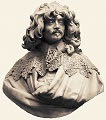|
|
 |
Male
Hairstyles
|
 |
The one item
which usually comes immediately into one's mind when thinking of
the second half of the 17th century and the early 18th century is
the long and full wig. The so-called periwig or Allonge
perruque.
In the first
half of the 17th century, it had been fashionable en lieu with the
flamboyant cavalier fashion, to wear one's hair long and in locks.
Often with one plaited strand of hair even longer and tied at the
end with a small ribbon bow, the lovelock. Yet even during
this period there is a mentioning of wigs, since not every man was
endowed with suitable hair to let it grow long, or he lost his hair
and grew bald after a certain age.
The wearing
of wigs did not become general until about 1660, but false additions
to the hair were commonplace aids.
Cropped hair
was worn by many Puritans and adherents of Cromwell in England.
Elderly men usually could not appear any longer with long natural
locks, and therefore before the wigs became the general rule wore
their hair at a "bob"-length or nearing the shoulders. Men with
thick, well-grown hair could simulate a modified form of the fashionable
coiffure without wearing a wig, while men wearing wigs had their
heads closely cropped or even shaved.
The frizzed
and crimped style of the early wigs, falling to the shoulders from
a centre parting, had very little shape except that its end were
curled horizontally and that it was divided into three parts, one
to hang down the back and the others to be brought forward over
the shoulders. From 1660 to 1675 those hanging in front might be
tied at the end with bows. This arrangement also applied to another
style, set in thick curls, which were clustered on the forehead
and lay horizontally on both sides of the face. The two thick locks
that descended to the shoulders in front were loosely ringleted.
The wig became
compulsory in the fourth quarter of the century. Most probably the
wearing of wigs was brought into fashion by Louis XIV, who, not
wishing to lose the admiration occasioned by his long, curled locks
when he grew bald, adopted the curled wig. Louis XIV had beautiful
long, brown hair in his youth, according to contemporary sources,
but he became bald early. Thus he appointed 48 royal wigmakers in
1655 and one year later there was a foundation of the first Parisian
wig maker guild. From that moment on when Louis grew bald, he wore
wigs and they immediately became status symbols of one's importance
at the French court. The form of the wig was still quite natural
around the middle of the 17th century, but soon curls were amassed
both at the back and the front, until the exaggeratedly long and
full curls covered the back often down to the waist, as well as
both sides of the chest. Furthermore, the wig gathered in height,
when the male hairstyle began to imitate the development of the
female hairdo.
Towards the
end of the 1680s, when the Fontanges began to tower tall
on women's heads, the male wig towered curls on top as well. Yet
the Allonge perruque ("A la Fontange") was to be rather
short-lived thereafter. The large, full-bottomed wig was often worn
with a mass of its luxuriant curls drawn forward over one shoulder,
while on the other only a few ringlets dangled, with the rest hanging
down the back. Black was fashionable, but various shades of brown
were also seen, and contemporary paintings usually show Philippe,
Duc d'Orléans 'Monsieur', Louis XIV's brother, with a blond
wig.
After 1675
the curls were tighter and more evenly arranged. The front of the
wig grew higher and the hair was usually raised in two points over
the brow on either side of a centre parting after 1690, the so-called
periwig. In some instances the periwig was so large that the wearing
of a hat became impractical, and it was carried instead. These wigs
were very expensive and due to the large amount of periwigs required,
the material was dubious because of its relative shortage. In England
during the Great Plague of 1665 and 1666, there were even rumours
that the hair of plague victims was used in the wigs' manufacture.
From 1675 onwards
a shorter but equally full wig was worn for travelling or sport,
because of the enormous size and weight of the periwig. From 1680
onwards it was occasionally tied back, especially by soldiers.
However, the
fashion of the periwig or Allonge perruque began to
wane rapidly after Louis XIV's death in 1715, and already in 1720
there were smaller and shorter wigs to be seen.
It is easy
to imagine that such a wig made from human hair was extremely expensive,
and that naturally, with such a large amount of human hair to be
needed, the more affordable wigs were made of dubious materials.
Less wealthy people, as well as ordinary soldiers, wore their own
hair grown as long as possible to imitate the periwig. But Officers,
who were usually recruited from the ranks of the aristocracy, wore
wigs as well, as can be seen on several paintings with battle scenes
from the period, they tied their long wigs in the back into a ponytail,
fastening it with a ribbon. The clerics, on the other hands, who
should show humility before God in their appearance as well, so
the church demanded half heartedly, didn't wear wigs according to
high fashion at first, but then there was no way to stop them anymore.
No matter if the pope forbade them or the Protestant church called
them 'satanic', about twenty years after the periwig had so triumphantly
conquered the lay fashion world, the higher rankings of the cleric
were wearing them as well. And as much later as they came into fashion
amongst the cleric, did the wearing of the periwig die out in the
18th century, still to be seen on bishops' heads while amongst the
lay fold small wigs a la Catogan were fashionable.
One last word.
One should also always bear in mind that there was no white powder
at all used on neither male nor female hair, the white powder is
a fashion, and only in evening wear, indoors for the grand occasion
of a ball etc. of the 18th century!

Female
Costumes
Ladies'
Baroque Clothing
Indoor
Garments | Footwear | Accessories | Hairstyles | Head-dresses | Development
of the Fontange
Hairstyles
by Vermeer | Dress
Colours by Vermeer | Head-dresses
by Vermeer
Costume Focus Headwear & Neckwear | Costume
Focus Working Women
Costume
Focus Children's Clothing
Ladies'
Costume Quotes
Male
Costumes
Gentlemen's
Baroque Clothing
Indoor
Garments | Footwear | Accessories | Hairstyles | Head-dresses
Costume
Colours by Vermeer | Hair-
and Head-dresses by Vermeer
Gentlemen's
Costume Quotes
~ ~ ~ ~ ~ ~ ~ ~ ~ ~ ~ ~ ~
Embroidery
Gallery | Gallery
of Needlework Engravings
Lace
Gallery & Identification | Glossary
Contents © N. Kipar 1997 |









